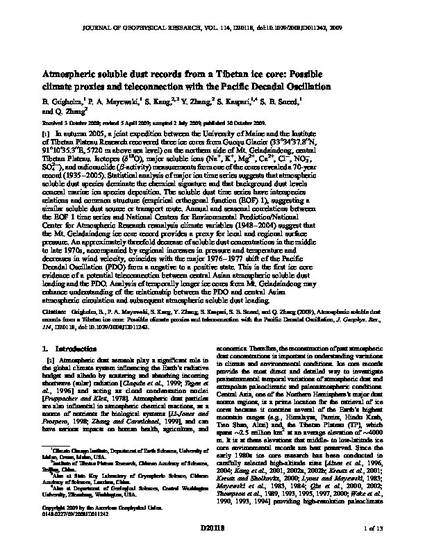
In autumn 2005, a joint expedition between the University of Maine and the Institute of Tibetan Plateau Research recovered three ice cores from Guoqu Glacier (33 degrees 34'37.80 '' N, 91 degrees 10'35.3 '' E, 5720 m above sea level) on the northern side of Mt. Geladaindong, central Tibetan Plateau. Isotopes ( delta(18)O), major soluble ions (Na(+), K(+), Mg(2+), Ca(2+), Cl(-), NO(3)(-), SO(4)(2-)), and radionuclide (beta-activity) measurements from one of the cores revealed a 70-year record (1935-2005). Statistical analysis of major ion time series suggests that atmospheric soluble dust species dominate the chemical signature and that background dust levels conceal marine ion species deposition. The soluble dust time series have interspecies relations and common structure (empirical orthogonal function (EOF) 1), suggesting a similar soluble dust source or transport route. Annual and seasonal correlations between the EOF 1 time series and National Centers for Environmental Prediction/National Center for Atmospheric Research reanalysis climate variables (1948-2004) suggest that the Mt. Geladaindong ice core record provides a proxy for local and regional surface pressure. An approximately threefold decrease of soluble dust concentrations in the middle to late 1970s, accompanied by regional increases in pressure and temperature and decreases in wind velocity, coincides with the major 1976-1977 shift of the Pacific Decadal Oscillation (PDO) from a negative to a positive state. This is the first ice core evidence of a potential teleconnection between central Asian atmospheric soluble dust loading and the PDO. Analysis of temporally longer ice cores from Mt. Geladaindong may enhance understanding of the relationship between the PDO and central Asian atmospheric circulation and subsequent atmospheric soluble dust loading.
Available at: http://works.bepress.com/paul_mayewski/53/
